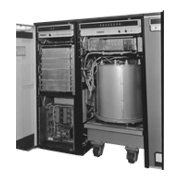This magnetic drum employed a floating head and had the highest performance among Japanese-made units at the time. It was commercialized in 1968 as a magnetic drum unit for the HITAC-8000 Series.
After developing a fixed head type magnetic drum in 1959, Hitachi had increased capacity, but by using the new floating head system, they were able to narrow the spacing between the magnetic head and the media on the surface of the rotor to 5μm (1/6 of the previous value) -thereby attaining a capacity of 2MB (megabytes), 6 times the previous capacity. A dual-body planar slider with stable floating characteristics was used for the new floating head, and mounting density was increased by using a 4-multi-track structure. This magnetic drum memory unit was configured to enable connection of up to a maximum of four 2MB magnetic drums to a single unit.
The features of this magnetic drum included an extremely short access time (10.3ms for the main unit) and extremely stable performance with few errors. It was used mainly for large high-speed electronic computers, but as capacity increased, it came into wide use in new fields.
This magnetic drum was a product which utilized the results of joint research by Nippon Telegraph and Telephone Public Corporation and Hitachi, Ltd.
| Unit model name | H-8566 | |
|---|---|---|
| Completion date | 1968 | |
| Head type | Floating head | |
| Head floating distance | 5 μm | |
| Memory capacity | 2 MB | |
| Recording system | TM recording system | |
| Average access time | 10.3ms | |
| Data transfer speed | 1.4Mbit/s | |
| Drum | Name of unit used | --- |
| Number of tracks | 512 | |
| Rotation speed | 3,000 rpm | |
| Rotor dimensions | 360 ø×470 mm | |
| Recording density | 25 bit/mm | |
| Connected systems | Digital switching systems Seat reservation systems HITAC-8000 Series |
|



